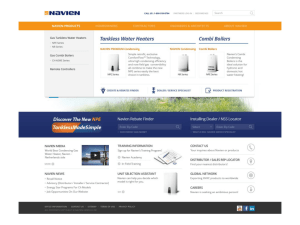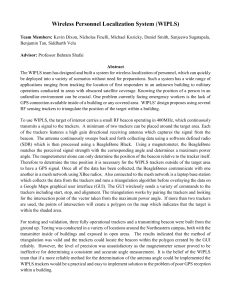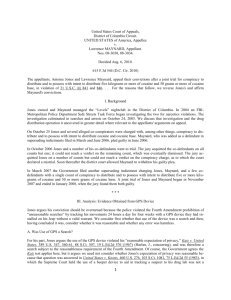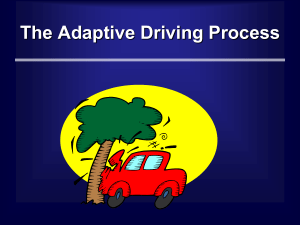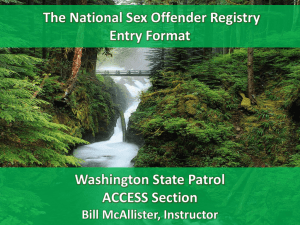295 - Michigan Prosecuting Attorneys Coordinating Council
advertisement
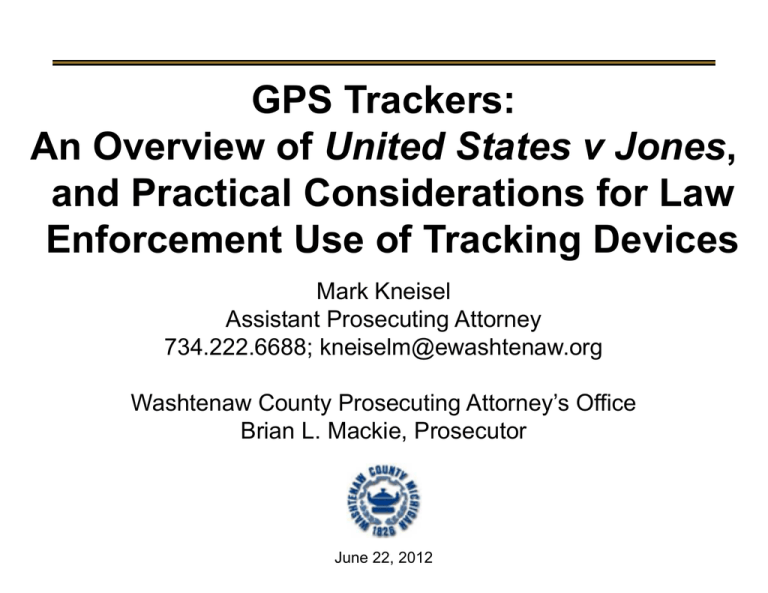
GPS Trackers: An Overview of United States v Jones, and Practical Considerations for Law Enforcement Use of Tracking Devices Mark Kneisel Assistant Prosecuting Attorney 734.222.6688; kneiselm@ewashtenaw.org Washtenaw County Prosecuting Attorney’s Office Brian L. Mackie, Prosecutor June 22, 2012 How Did We Get Here? Fourth Amendment: “The right of the people to be secure in their persons, houses, papers, and effects, against unreasonable searches and seizures, shall not be violated, …” Search and Seizure caselaw was tied to trespass model until mid-1900s. In 1967, United States Supreme Court made a person’s “reasonable expectation of privacy” the main inquiry. How Did We Get Here? Monitoring of “primitive” electronic tracker (beeper) that amounted to the following of a car on public streets was not a search because it did not invade a reasonable expectation of privacy. – – United States v Knotts, 460 US 276 (1983). When “…‘twenty-four hour surveillance of any citizen of this country will be possible, without judicial knowledge or supervision’…there will be time enough then to determine whether different constitutional principles may be applicable.” Knotts, 460 US at 283-284. How Did We Get Here? Installation of “primitive” beeper into a canister, and transfer of that canister to a suspect, infringed no privacy interest of that suspect. – United States v Karo, 468 US 276 (1983). Both Knotts and Karo addressed the distinction between trespass and privacy analyses, and foresaw more sophisticated technology. United States v Jones, 132 S Ct 945. January 23, 2012. Facts: – FBI obtained warrant that gave ten days to install device on D’s wife’s car in District of Columbia. On day eleven, FBI installed device on wife’s car in public parking lot in Maryland; FBI activity was therefore warrantless. Government chose to argue that installation and use were not even a search. Two distinct majority opinions? United States v Jones, 132 S Ct 945. Two – – – Justice Scalia wrote for four Justices (Opinion). Justice Alito wrote for four Justices (Concurrence). Justice Sotomayor agreed with both Justice Scalia and Justice Alito – two “majority” rationales. The – – Distinct Rationales Opinion of the Court The historical trespass underpinnings of the Fourth Amendment are re-established. “…Government's installation of a GPS device on a target's vehicle, and its use of that device to monitor the vehicle's movements, constitutes a ‘search.’” United States v Jones; Concurrence Concurrence would retain (and expand) Reasonable Expectation of Privacy analysis. – – – – Implicitly endorses “mosaic” theory developed by lower court. Even without a trespass, long-term monitoring violated Jones’ reasonable expectation of privacy. GPS monitoring can alter relationship between citizens and government in ways inimical to democratic society (Sotomayor, paraphrased). On-Star; Cellphone Tracking; Drones; …. Now What? Pending cases involving pre-Jones (January 23, 2012) uses of GPS trackers. – – – – Standing. Distinguishable facts. Inevitable Discovery/Independent Source. Good Faith Exception. Future – uses of GPS trackers. Jones was silent on warrant requirement, but warrants should be used. Pre-Jones Situations U.S. – – Warrantless tracking of non-contraband personal property (cars?) in public places was permissible? Good Faith Exception? U.S. – – v Bailey, 628 F2d 938 (CA 6, 1980). v Luna-Santillanes, 2012 WL 1019601. Standing is defendant-by-defendant. Inevitable Discovery. Search Warrants for GPS Trackers Square MCL Pegs in Round Holes. 780.651 et seq. Templates. – – – Always Exercise Caution When Using Any Template. GPS Templates “Cribbed” From Federal Orders Have Unnecessary Nighttime Permission Language. Templates Are Not the Gospel; Consider Underlying Rationales, Then Mix and Match (AND REMOVE EXRANEOUS) Template Language to Suit Particular Situations. Important Concepts Investigate and Articulate Ongoing/Future Reasonableness of Search. Installation/Maintenance/Removal in Locations Accessible to the Public, or With a Second (or TwoPart) Warrant. Suspect Must be Informed that His Car Was Tracked. – But not until he’s charged. Return/Tabulation – Dates/Times/Locations Instead of Things. Prepare Your Judges (not your magistrates). Location Accessible to Public Basic Template Addresses Vehicle Only. Warrant Authorizes Installation/Maintenance/Removal, But Only at Locations Accessible to the Public. – – – – Accessing or Re-Accessing Device/Vehicle in Garage or on Curtilage Requires a Second, or a Two-Part, Warrant. If You Have to Cross a Threshold or Jump a Fence, You Need Judicial Authorization United States v Dunn, 480 US 294 (1987). People v Powell, 477 Mich 860 (2006). Probable Cause In Addition to “Traditional” Probable Cause, Be Sure to Tether Your Tracking Request to a Crime in Your Jurisdiction & to Establish Probable Cause for the Future/Ongoing Reasonableness of the Monitoring Tabulation Must – Detail Each Time You Access Vehicle/Device. Location, Date, Time Must Must Detail When Monitoring Began and Ended. Give Tabulation to Vehicle Owner/User & (if applicable) Owner of Private Property You Entered to Install/Maintain. Five Templates Basic – (Alpha) Install and Monitor on S-1’s Car; Accessible to Public Private – Property (Bravo) S-1’s Car; S-1’s or Other’s Private Property Already – Permission to Monitor Only. Already – Installed (Delta) Permission to Enter Private Property for Maintenance. Already – Installed (Charlie) Installed (Echo) Extension of Monitoring Duration Basic Template (Alpha) Fill In Exact Deadline Date for Installation. 45-Day Tether Car Duration? 30-Day? Use of Tracker to Your/Judge’s Jurisdiction. Owner versus Car’s Primary Driver. Tabulation – – (and Return) Dates/Times/Locations Serve on Owner/Primary Driver When Charged. What if No One is Ever Charged? Private Property (Bravo) Installation on Private Property Involves Two Distinct “Intrusions” Requiring Judicial Authority Both Intrusions Must Be Described With Particularity – – Description of Vehicle Description of Property (Address) Already Installed (Charlie) Installed With Consent, or In Exigent Circumstances Get Judicial Authorization to Begin Monitoring ASAP Maintenance on Private Property (Delta) Entering Private Property Is a Separate Intrusion Requiring Judicial Authorization Extension of Tracker Duration (Echo) Articulate New Information that Makes Additional Monitoring Reasonable. – – – Additional Suspects. Additional Crimes. S-1 Out of Service for Several Weeks (Jail). Tactical/Practical Considerations Have a Plan Before Installation, Maintenance, Removal Talk to the Feds Hard-Wired Devices versus “Slap-Ons” Maintain All Location Information – – Not part of tabulation. Failure to maintain and present location information as part of discovery will draw Brady motions. Where Are We Going? Future Legislative Action? Tracking United Cell-Phones; Tracking On-Star; Drones. States v Jones May Undermine Future Good Faith Exception Arguments for Other Surveillance Practices. Internet Resources fourthamendment.com volokh.com usvjones.com Mark Kneisel Assistant Prosecuting Attorney Direct Line: 734-222-6688 Email: kneiselm@ewashtenaw.org


